What Is the 1962 Lincoln Penny Made Of?
The 1962 Lincoln penny is made of 95% copper and 5% zinc. From 1909 to 1942 and from 1944 to 1982, the Lincoln penny was made of copper and zinc or tin. 1943 was kind of different because the penny was made of zinc-plated steel. Then in 1982, the US Mint switched it to copper-plated steel, meaning there is 97.5% zinc and 2.5% copper.
In 1909, the penny is referred to as wheat pennies because it has two stalks of wheat as the design for the reverse. This lasted until 1958. By 1959, the Lincoln Memorial replaced the wheat. By 2010, the Lincoln Memorial was then replaced by the Union Shield designed by Lyndall Bass.
To learn more about the 1962 Lincoln penny, here are some of its specifications:
- Value: 1 cent
- Mass: 3.11 g
- Diameter: 19.05 mm
- Edge: Plain
- Years of minting: 1909 up to present
There were two artists who designed the 1962 Lincoln penny. These are Victor David Brenner for the obverse and Frank Gasparro for the reverse.
The artists were allowed to add their initials to the coin. However, in 1909, people noticed that Brenner’s initial, which was VDB, was too big. As a result, the initials were removed just after a few days. The initials of Brenner would then be restored in 1918, this time, the initials were smaller.
Originally, the US Mint chose Augustus Saint-Gaudens to design the Lincoln penny. Sadly, he died in August 1907 before finishing the project. Thus, Brenner was chosen for the task.
Now, talking about the design, the 1962 Lincoln penny features the image of Abraham Lincoln, the sixteenth president of the United States.
On top of his head is the inscription IN GOD WE TRUST, inscribed in an arching manner. On his left is the word “LIBERTY,” which is one of the most essential founding principles of the United States. In front of him is the year of the series, which is 1962.
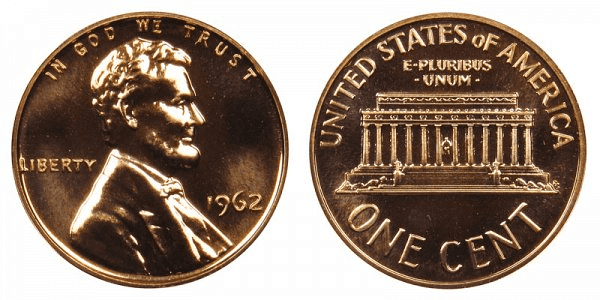
The reverse, as mentioned, has the front view of the Lincoln Monument. Inscriptions include the following:
- UNITED STATES oF AMERICA
- E PLURIBUS UNUM (Latin for “Out of many, one.”)
- ONE CENT
The year 1909, the same year when the Lincoln penny was first struck, was the same centennial year of Lincoln’s birth. So the timing of adding Lincoln to the coin was just right.
Prior to 1909, the overall feeling of the general public was that having a US president on a coin felt like it is excessively monarchical. That is the reason when the plan that Lincoln’s face will be added to the US penny was announced, some believed that it won’t be generally accepted by the public.
Yet, when the Lincoln penny was released, contrary to popular belief, the public was happy to see the coin. The Lincoln penny became the first and most widely issued US coin with a president’s face. It has then paved the way for other coins to have a president’s face on them.
1962 Lincoln Penny Varieties
The 1962 Lincoln cent or penny has three official varieties issued by the U.S. Mint. These are the 1962 P, 1962 proof, and 1962 D Lincoln pennies. There were a total of over 2.4 billion pennies struck in 1962.
Aside from the standard varieties, there are error penny coins, which gave rise to different and new varieties.
Take a look below to know more about the 1962 Lincoln penny varieties:
1962 D Lincoln Penny
Year of minting: 1962
Mint Mark: D
Place of minting: Denver
Quantity produced: 1,793,148,400
Face Value: $0.01 (one cent)
Price: $0.01 to $7.00 (or more)
Mass: 3.11 grams
Edge: Plain
Designer: Victor D. Brenner (obverse) / Frank Gasparro (reverse)
Composition: 95% copper and 5% zinc
Diameter: 19.05 mm
Thickness: 1.52 mm
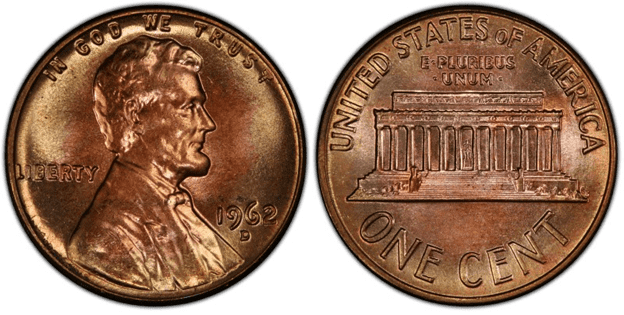
The Denver Mint produced more than 1.79 billion 1962 D pennies. In the following year, in 1963, the Denver Mint also produced almost the same number of pennies. So, you can see here that the penny is actually abundant.
You can buy 1962 pennies for about $0.01 to $7.00 if the coin is in circulated condition. The price can be higher if it is favorably graded.
According to the PCGS, the 1962-D is difficult to find in grades of MS-66 and higher. In fact, it’s the second most difficult to find, next to 1963-D. Most collectors would try to go through original rolls and unsealed Mint bags only to find 1962-D pennies in MS-62, MS-63, and MS-64 condition. MS-65 graded pennies are also difficult to find.
1962 P Lincoln Penny
Year of minting: 1962
Mint Mark: None
Place of minting: Philadelphia
Quantity produced: 606,045,000
Face Value: $0.01 (one cent)
Price: $0.01 to $7.00 (or more)
Mass: 3.11 grams
Edge: Plain
Designer: Victor D. Brenner (obverse) / Frank Gasparro (reverse)
Composition: 95% copper and 5% zinc
Diameter: 19.05 mm
Thickness: 1.52 mm
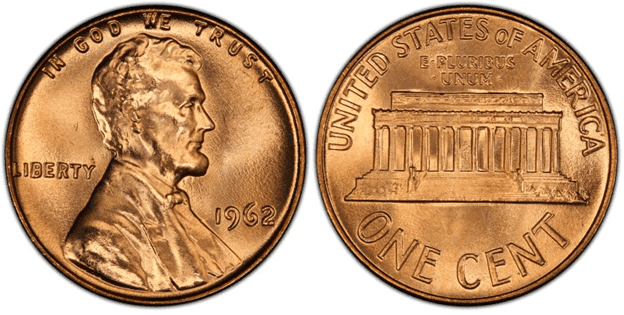
The Philadelphia Mint produced more than 606 million Lincoln pennies in 1962. In the following year, the same mint would produce more than 700 million. Its price can start from $0.01 to $7.00. Rare and unique coins can be more expensive.
The 1962-P pennies are rare in MS-66 grade. However, there are still thousands of pennies with grades of MS-65 and below. As of now, there are no 1962-P pennies that received a grade of MS-67 and higher.
1962 Lincoln Penny (Proof)
Year of minting: 1962
Mint Mark: None
Place of minting: Philadelphia
Quantity produced: 3,218,019
Face Value: $0.01 (one cent)
Price: $0.01 to $10.00 (or more)
Mass: 3.11 grams
Edge: Plain
Designer: Victor D. Brenner (obverse) / Frank Gasparro (reverse)
Composition: 95% copper and 5% zinc
Diameter: 19.05 mm
Thickness: 1.52 mm
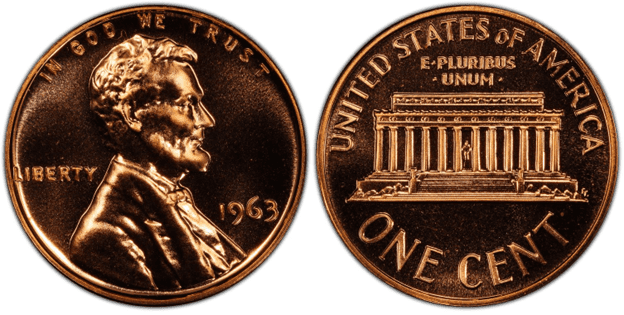
Aside from producing regular strike pennies, the Philadelphia Mint in 1962 produced proof coins as well. Today, the Philadelphia Mint is more focused on producing regular pennies and the San Francisco Mint usually produces proof coinage.
The proof coins are shinier, more detailed, and more gorgeous than the regular-strike coins. In 1962, there were only 3.2 million proof pennies. However, the low mintage wasn’t an issue since proof pennies were issued for collectors and not for circulation. The price tag most people give is around $0.01 to $10.00.
List of 1962 Lincoln Penny Errors
There are billions of 1962 Lincoln pennies. So, it’s not surprising to note that there are Lincoln error pennies that sporadically appear. it’s just a matter of time before some coins will be made with errors. Yes, the US Mint doesn’t want to have any error coins, but a lot of enthusiasts are more than happy to add these types of coins to their collection.
Error coins happen due to different reasons. Here are some of the most common ones:
- Foreign materials got into the minting process
- Mechanical failure
- Incorrect cutting of planchet
- Wear and tear of the minting equipment
- Break in the die
- Human error
- Misalignment in the die and planchet placement
- The coin was struck more than once
Errors may happen in any stage of the minting process. One error is called the broad strike. The planchet isn’t held properly and when the die strikes the planchet, it spreads out like a pancake.
Here’s an example:
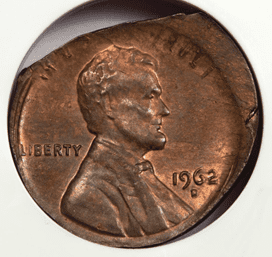
Another error is the off-center strike. The die struck the coin at the wrong angle. Here’s an example:
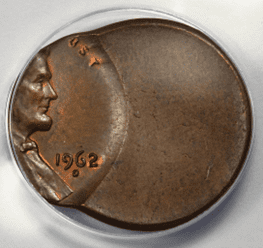
This could happen if there’s a misalignment between the die and planchet. In this example, there’s a 60% off-strike error.
Lamination error happens during the formation of the planchet. When the planchet is being produced, it cracked and peeled as you can see here:
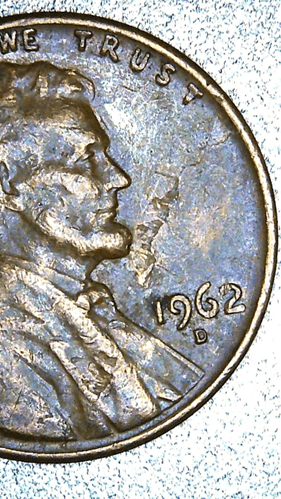
There are also coin errors that seem to have a lot of errors. Here’s an example:
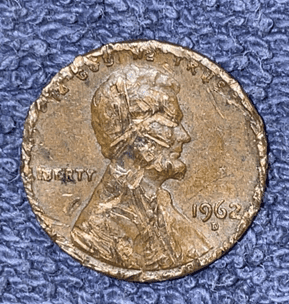
How Much Is the 1962 Lincoln Penny Worth Today?
The 1962 Lincoln penny has a face value of $0.01. It has a melt value of $0.0240, which is slightly higher than its face value.
You might think that the 1962 Lincoln penny isn’t worth much, but actually, there are some 1962 pennies that are worth more than their face value. Since 1962 pennies are old, if you have any of these in good condition, you might still be able to sell them at a higher price.
To give you an example, here’s a 1962 Lincoln Penny values chart:
| Coin | Condition | Grade | Mintage | Value |
| 1962 D Lincoln penny | Circulated/mint | Not graded | 1,793,148,400 | $0.01 to $7.00 |
| 1962 D Lincoln penny | Uncirculated/mint | MS-65 | 1,793,148,400 | $7 to $10 |
| 1962 D Lincoln penny | Uncirculated/mint | MS-66 | 1,793,148,400 | $9 to $46 |
| 1962 D Lincoln penny | Uncirculated/mint | MS-67 | 1,793,148,400 | $299 to $1,560 |
| 1962 P Lincoln penny | Circulated/mint | Not graded | 606,045,000 | $0.01 to $7.00
|
| 1962 P Lincoln penny | Uncirculated/mint | MS-65 | 606,045,000 | $7 to $19 |
| 1962 P Lincoln penny | Uncirculated/mint | MS-66 | 606,045,000 | $25 to $40 |
| 1962 P Lincoln penny | Uncirculated/mint | MS-67 | 606,045,000 | $180 to $1,080 |
| 1962 Proof Lincoln penny | Circulated/proof | Not graded | 3,075,645 | $0.01 to $7.00 |
| 1962 Proof Lincoln penny | Uncirculated/proof | PR-67 | 3,075,645 | $10 to $66 |
| 1962 Proof Lincoln penny | Uncirculated/proof | PR-68 | 3,075,645 | $9 to $66 |
| 1962 Proof Lincoln penny | Uncirculated/proof | PR-69 | 3,075,645 | $15 to $160 |
As you can see here, the 1962 penny is still worth a lot of money. If you have a penny, which is still in good condition, rare, and with a high grade, then you can expect that you are holding a more valuable penny.
Just to give you an idea, according to PCGS, the most expensive 1962 D was sold for $12,000 in May 2013. For the 1962 P, the auction record is $8,813, which is an MS-67-graded coin sold in February 2014. For the 1962 proof penny, the record shows that a PR 65 1962-P proof coin was sold for $1,265 in October 2006.
How Does The Grading System Work?
The Sheldon Scale is used by numismatists to provide a numerical value to coins. The Sheldon Scale goes from poor (P-1) to perfect mint state (P-1) (MS-70). Coins were originally evaluated using words to reflect their condition (Good, Fair, Excellent, Etc.). Unfortunately, coin collectors and dealers had different ideas about what each of these terms represent.
Professional numismatists joined together in the 1970s and established CoinGrading standards. These numismatists now assign grades at key places on the seventy-point scale, using the most regularly utilized numeric points in conjunction with the original adjective grade. The following are the most common coin grades:
-
-
- (P-1) Poor – Indistinguishable and probably damaged; if used, must have a date and mintmark; otherwise, rather battered.
- (FR-2) Fair – Nearly smooth, but without the damage that a coin graded Poor often possesses. The coin must have enough detail to be identified.
- (G-4) Fair – Inscriptions have merged into the rims in some areas, and important elements have been mostly erased.
- (VG-8) Very Good- A little weathered, but all of the primary design elements are visible, albeit faintly. There is little if any, central detail left.
- (F-12) Good – The item is very worn, yet the wear is even, and the overall design details stand out clearly. Rims are almost completely isolated from the field.
- (VF-20) Very Fine – Moderately weathered, with some finer features still visible. The motto or all letters of LIBERTY are readable. Both sides of the coin have entire rims that are separated from the field.
- (EF-40) Extremely Fine – Gently used; all gadgets are visible, and the most important ones are bold. The finer details are bold and clear, however, light wear may be seen.
- (AU-50) Uncirculated – Slight evidence of wear on the coin’s design’s high points; may have contact marks; eye appeal should be adequate.
- (AU-58) Uncirculated Choice – Slight traces of wear, no severe contact marks, almost full mint shine, and great eye appeal.
- (MS-60) Mint State Basal – Strictly uncirculated; no indication of wear on the coin’s highest points, but an unsightly coin with reduced luster, visible contact marks, hairlines, and other flaws.
- (MS-63) Mint State Acceptable – Uncirculated, but with contact scratches and nicks, little reduced shine, but otherwise appealing appearance. The strike is weak to average.
- (MS-65) Mint State Choice – Uncirculated with great mint shine, very little contact blemishes, and exceptional eye appeal. The strike is unusually severe.
- (MS-68) Mint State Premium Quality – Uncirculated with superb luster, no obvious contact marks to the naked eye, and exceptional eye appeal. The strike is quick and appealing.
- (MS-69) Almost Perfect Mint State – Uncirculated with perfect brilliance, a sharp and appealing strike, and extremely good eye appeal. A near-perfect coin with minor imperfections in the planchet, strike, and contact markings (seen only under 8x magnification).
- (MS-70) Mint State Perfect – Under 8x magnification, there are no tiny imperfections discernible; the strike is crisp, and the coin is perfectly centered on a beautiful planchet. Rarely seen on a coin, this coin is bright and whole, with original luster and exceptional eye appeal.
-
Where To Buy Or Sell 1962 Lincoln Penny?
There are different places where you can buy or sell 1962 coins.
The first and quickest option would be the Internet. You can find a lot of 1962 Lincoln pennies online. You can go to Amazon, eBay, and Etsy where people sell and buy 1962 pennies. You can also do a Google search. Use keywords like “Where to buy 1962 pennies” or “Where to sell 1962 pennies.” You should get hundreds of helpful sources.
Aside from the Internet, you can go to coin shops and antique stores. Look for auctions as well. You can join local, national, or even international clubs or groups of coin collectors. They can be a good place to find people who would like to buy your coins.
FAQs
Is there a rare 1962 penny?
The rare pennies are the ones with at least an MS-66 grade. The higher the grade, the rarer the coin can be.
How do I know if my 1962 penny is valuable?
The first thing you can do is do a visual inspection. You need to check the level of preservation, the strike, and the overall attractiveness of the coin. If you can see that it is still in superiorly good condition, then it is more likely your 1962 penny is valuable. Aside from that, look for unique attributes that make the coin even rarer.
Is the 1962 Lincoln penny copper or silver?
The 1962 Lincoln penny is made of copper and zinc. It is not made of silver.
How do you clean old pennies?
Clean old pennies by using a clean tap or distilled water. Baking soda, salt, and lemon juice can also be used to remove dirt. Gently use a toothbrush to get rid of tough blemishes.
